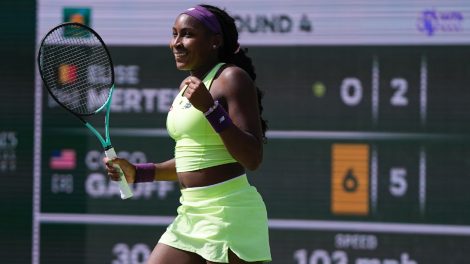The easy response is to say let’s start talking about Canadian female tennis players other than Genie Bouchard.
It’s pointless, after all, to keep talking about her as if the 2014 run to the Wimbledon final was yesterday. Or even last year.
It’s unfair to her as well. She’s not that player she was four years ago. She sits outside of the top 100 players in the world and needed wild card generosity to play in her home country’s national tournament.
Let’s evaluate her for the player she is now, and the player she is likely to remain.
Problem is, if we wish to move the conversation to other Canadian female players, we’re kind of stuck.
Bouchard, at No. 129 in the world, is the highest-ranked player from her country. It’s true. We don’t have a player in the top 100, or even the top 125. Bouchard is one of only two Canadian female players in the top 150, (Carol Zhao is No. 137) but the player many believe is worth watching, 18-year-old Bianca Andreescu, is No. 192.
It’s not quite a crisis, but Tennis Canada needs to start treating this problem with some urgency.
While Felix Auger-Aliassime was giving strong evidence on Tuesday afternoon that Canada could soon have three men capable of being top-20 players on the much more competitive men’s pro tennis tour, something has gone seriously wrong with Tennis Canada’s development stream for female players.
Right now, the most inspirational story is that of 27-year-old Rebecca Marino, who is penning a remarkable comeback tale after five years away from professional tennis because of personal problems, including depression. Marino lost in Rogers Cup qualifying in Montreal this week, but the mere fact she won her first match and was part of the qualifying competition at all was enormously positive news for those tracking her progress.
Marino was once No. 38 in the world. Could she make it back that far? At this point, who knows, but the whole country should be cheering for her, and she’s getting lots of helpful support from the national federation.
Gabriela Dabrowski, meanwhile, has two Grand Slam mixed titles in last two years, and a lot of good results in women’s doubles. She’s not Daniel Nestor — yet — but the 26-year-old Dabrowski has certainly been making her mark as a doubles specialist and a stalwart on Canada’s Fed Cup team.
But in terms of serious, elite singles players? This is like what the men’s side was like before Milos Raonic started to roar his way up the rankings.
Andreescu was injured and couldn’t even play in Montreal. Bouchard, meanwhile, went down early again in the Rogers Cup on Tuesday, losing to the much higher ranked Elise Mertens of Belgium. It would have been a shocking upset had Bouchard pulled it off, and starting off losing the first five games of the match certainly underlined that reality.
In the second set, Bouchard actually led 3-0 and seemed to have some momentum, but then she dropped six of the final seven games to lose in straight sets.
Not much to analyze here, folks. Mertens is No. 15 in the world and, while she stumbled a little in the middle of the match, she wasn’t threatened any more by Bouchard than you would expect. Peter Polansky was ranked No. 122 in the world on the men’s side when he knocked off Matthew Ebden on Monday in a pleasant surprise and, really, it’s time to start evaluating Bouchard’s results in the same way we evaluate Polansky’s results.
If there comes a time in the future when she fights her way back in the top 50 and shows some noteworthy developments in her game, then we can revisit the issue.
[relatedlinks]
What’s really unfortunate for Bouchard is how she’s been unable to use the Rogers Cup as any kind of home court advantage. Instead, it’s been an annual house of horrors for her, and now she’s won only four Rogers Cup matches on home soil in a decade. Putting her on centre court year after year is probably doing her no favours.
There was a time when Tennis Canada looked hard at how the country was developing players of both genders and made big changes, including developing national tennis centres in Toronto and Montreal. It’s worked beautifully for the men and, for a time when Bouchard seemed to be becoming a star and Francoise Abanda looked to have great potential, it seemed to be working for the women as well.
But that’s not longer the case. There are obviously some different, unique challenges here. Michael Downey was in charge of Tennis Canada when the national centres were established. Now is probably the time for Downey, who is back in charge again, to announce the federation is taking a hard look at why Canada is developing so many top male players and so few top females.
Right now, it’s bleak for Canadian women’s tennis. That could change, but probably not without Tennis Canada taking a hard look at the process.









